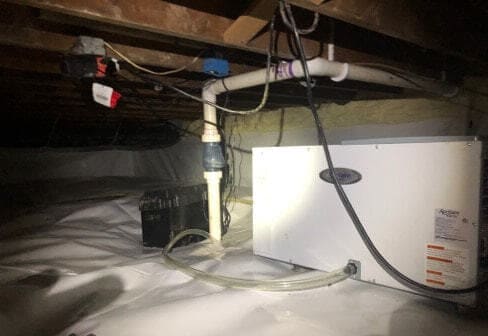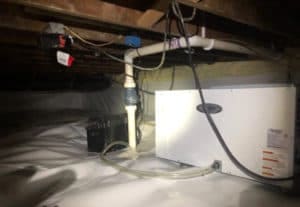What Does Crawl Space Encapsulation Cost? Components and Prices.

Originally posted 1/30/20, updated 12/14/22
There could be a number of factors that might lead you to consider encapsulation. Maybe it’s because you need additional storage space. Maybe you’re tired of the musty smell that seeps into your house on days with high humidity. Or you’re frustrated by allergy symptoms that persist despite your best efforts- after all, the air in your crawl space is regularly circulated throughout the house. Maybe you’ve recently had to spend $5900 to repair joists and beams to correct sagging floors, and you don’t want to do so again.
Whatever your reasons, Acculevel is here to help. We’ve installed encapsulation in thousands of homes since our start in 1996, and we’re going to review the various components, their purpose, and their costs. Keep in mind that this article assumes you have water drainage already; if you don’t, we review the costs for that process in another article.
In the last twelve months, Acculevel customers have paid an average of $3800-$5200 for encapsulation.
 This picture was taken by an Acculevel project advisor during a free estimate appointment. Mold is growing on the floor joist, and damp fiberglass insulation is hanging down. The plastic on the ground is a vapor barrier that needs removed/replaced.
This picture was taken by an Acculevel project advisor during a free estimate appointment. Mold is growing on the floor joist, and damp fiberglass insulation is hanging down. The plastic on the ground is a vapor barrier that needs removed/replaced.
If you have questions about waterproofing, sagging floor issues, or unpleasant odors in your crawl space, consult our comprehensive Crawl Space Repair Guide for Homeowners!
The Components
Spray Foam- How it Works and What it Costs
In the past, fiberglass insulation was the common material used in crawl spaces. Over time, we’ve learned that this is a terrible idea. Fiberglass will absorb and store moisture like a sponge, which means there’s a layer of wet material wedged in between the wooden joists and beams of your flooring structure. This transfers the moisture to the wood, which encourages mold, mildew, and rot. The wet insulation also provides nesting materials for all manner of pests: rodents, termites, even mosquitoes.
Spray foam insulation is a chemical mixture that can be sprayed into small cracks and crevasses. Once applied to a surface, the spray expands into a foam-like structure that seals out air and moisture. Generally, homes need fiberglass insulation removed and spray foam installed; the cost for this is $12-$16 per linear foot around the perimeter of the crawl space.
White Cap Barrier Versus Vapor Barrier
You may have originally had a vapor barrier installed in your crawl space. This is a layer of plastic laid on the dirt “floor” of the crawl space, and it’s usually a thinner plastic between 3-6 millimeters thick. It keeps out the worst of the odors and vapors -hence the name- that come into your house through the ground. But it doesn’t keep out moisture and only lasts 5-10 years; after that time, it begins to break down and deteriorate. Acculevel does install vapor barriers; we use a 6 ml thick plastic, and it costs approximately $3-5 per square foot.
A white cap barrier is much heavier than a vapor barrier. It is installed throughout the crawl space, across the floor, AND up the walls. The seams are sealed, and the white cap is secured around the walls and support columns of the crawl space.
The white cap that Acculevel uses is a polyurethane membrane interlaced with high-density fibers. This encapsulation material is the strongest and most puncture-resistant on the market. And since it’s inorganic, it will not support mold. White cap has a 25-year warranty and costs $5-7 per square foot.
 This picture was taken by an Acculevel crew member after an encapsulation. White cap covers the walls & floor, spray foam seals the white cap & gaps of the wooden floor system. A dehumidifier is installed & connected to the sump pump to keep the crawl space moisture free.
This picture was taken by an Acculevel crew member after an encapsulation. White cap covers the walls & floor, spray foam seals the white cap & gaps of the wooden floor system. A dehumidifier is installed & connected to the sump pump to keep the crawl space moisture free.
Why Do You Need a Dehumidifier?
This is a frequently asked question, and a very reasonable one. After all, you have a water drainage system and a sump pump outside the white cap that controls any water that comes through your foundation. But managing the water outside the encapsulation does not guarantee a 100% dry crawl space inside the encapsulation.
In the Midwest, the frequent temperature and humidity changes cause significant amounts of condensation to gather on your HVAC system, duct pipes, water pipes and drain pipes. Once you have the crawl space sealed with white cap and spray foam, any moisture that develops inside is trapped. A dehumidifier eliminates this moisture collecting in the crawl space, and cleans the air that gets circulated throughout your home. The cost to install a dehumidifier is $2175-2650, covers up to 5,000 square feet, and has a 5-year manufacturer’s warranty.
What Can Increase Your Costs?
- Water damage to the structural wooden flooring system means that you need joists or beams repaired. The costs for this vary, depending on the amount of damage.
- Mold growth will need to be treated. The costs for this depend on the severity of the growth, as well as the size of the area affected.
- Insect damage or pest control- if you have unwanted visitors in your crawl space, these will need to be removed and any damages repaired. As this is not a service we offer, we cannot provide accurate pricing information. But it’s important that you choose a service that has certified and licensed technicians to guarantee the safety of your family and pets. A reputable company will have applicable and up-to-date credentials for you to review. If you have any questions, your State Department of Agriculture can verify their validity for you.
- A larger home will need more white cap barrier and spray foam application. We estimate the average crawl space to be 1500-2000 square feet.
What Can Decrease Your Costs
- A newer home may already have spray foam insulation installed. If this is the case, your home will have a lower risk of water damage to the flooring system. You probably won’t need any debris removed, either.
- If you have a quality dehumidifier already in your crawl space, or if your HVAC system has this component built into it. It will be important to check the installed dehumidifier’s capacity, to be certain it can thoroughly manage the workload.
- A smaller than average crawl space will reduce your costs, as it will take fewer materials to complete the encapsulation. This doesn’t necessarily mean that your home is smaller than average- some homes have a basement under the majority of the home with only a partial crawl space.
Are You Ready to Encapsulate Your Crawl Space?
The next step is to find an experienced company, and make an appointment. Before you sign a contract for any service, always verify the company is reputable, insured, and accredited by the Better Business Bureau. You’ll also want to make sure that you evaluate several companies to make sure you’re getting the best combination of price and service.
If you live in Indiana or the surrounding states, contact Acculevel. An experienced project advisor will evaluate the areas of concern and recommend the best course of action for you, to keep your home strong and healthy for years to come.